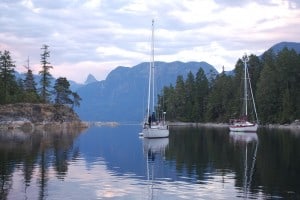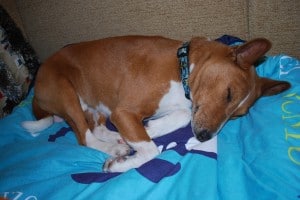It was a dark and stormy day . . .
I kinda’ like that line – I wonder if it’s ever been used to open a story?????
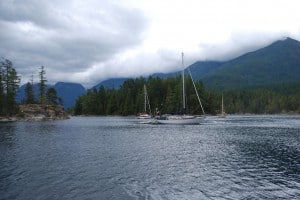
It doesn't look all that dark and stormy, until that is, you compare the photo above and below, both looking towards Mt. Denman from our anchorage in Prideaux Haven. The above photo was taken as I wrote this; the one below was taken last evening just after sunset.
It’s September 9th as I start this post. We’re safely tucked aboard Flying Colours at anchor in Prideaux Haven in the heart of Desolation Sound – named by George Vancouver during his mapping expedition in the summer of 1792, stating in his log “there was not a single prospect that was pleasing to the eye”. So here we are, late in the summer of 2012, and even though it’s a stormy day, the skies are overcast, the wind is blowing gusts at 25 knots, and the temperature is 67°F – I can’t imagine a more wonderfully pleasing sight to the eye. Poor old George – to not see the incredible beauty of this place, he must have been either oblivious to that side of life, or snortin’ too much stuff up his nose that day!
(Remember, you can click on any photo to enlarge. Also don’t forget that the formatting of this blog entry is better – and the captions line up with the photos – when you can better read it online at www.ronf-flyingcolours.com – click on this link to go there. Also, if you’re logged into the post with your own userid, you can request an automatic update whenever a new blog post is put up – just click on the Subscribe link and give it your e-mail address. You cannot do this, though, if you’re logged in using the “friends” username.)
Caution: If you see any links in this blog post (other than the one above for the blog site), do not click on them. For some unknown reason, malicious links are showing up in this post. I think there’s a bug in WordPress, the software that I use to publish this blog. Anytime you see a word in blue, with a double underline, it’s a phony link – don’t click on it!
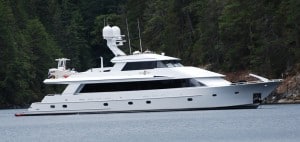
The Golden Boy II - a 115' charter yacht. My heart sinks every time a yacht like this comes into view. They're typically laden with crass people, loaded with jet skis that buzz around like gnats that you can't get away from, and they just spoil the view. This one is registered in the Cayman Islands, so it's probably one of Mitt's friends who helps him park some of his money in tax-free havens there. Oh well, to each his own.
Well, that’s if you don’t include the (to our eye ugly) Golden Boy II – a 115′ charter yacht that just pulled into Prideaux Haven and ruined the neighborhood. Many of these mega-yachts are in charter service, and when I did a Google search on the boat’s name, it came up with a dozen hits, all indicating that it’s in charter service out of Seattle – for a mere $54,500/week – and indicates that’s the “low rate”. You can see the listing for it at http://www.yachtstore.com/luxuryYachtDetails/684/GOLDEN%20BOY%20II.
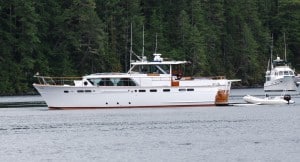
The Tahoe, a 60' Chris Craft Constellation (usually referred to as a "Connie") - one of the most classic of all motor yachts. Built in the 1960s, though, it's probably a bear to maintain, so keeping it up has to be a labor of love.
So, I ask you, compare the Golden Boy II to the Tahoe, a classic boat out of Seattle that came in about an hour before it. She’s a Chris Craft Constellation (that I think is about 60′), and for me, this Connie, while half the length, is twice the boat. And more to the point, it looks like a yacht, and not a Nike running shoe like the Golden Boy does. Unfortunately, the population that grew up watching the Love Boat on TV probably thinks the Golden Boy is gorgeous.
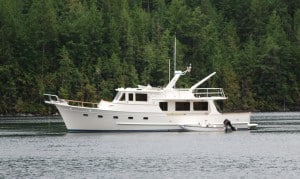
The Couverden - a Fleming 55, and one of the most beautiful boats on the water, also with truly classic lines, not to mention a beautiful handling boat.
Or look at the Couverden, our friend’s Fleming 55 that we’re cruising with for the next couple of weeks. But enough of my high-handeness (sometimes it just runs away from me when a boat like the Golden Boy II hoves into view and just drips of ostentatious over-consumption.
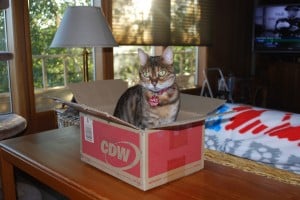
ZuZu is more at home in "her box" than anywhere else. It's a waste of time and money to shop for cat toys at the local pet store - give her an old box and maybe a wadded-up ball of tin foil and she's in cat heaven.
But I’m getting way ahead of myself. When I last wrote – on August 10th – we had just left Flying Colours at April Point Marina, across Discovery Channel to the east from Campbell River, and headed home for a month of looking after the house construction. As expected, that was a month of very frequent meetings and full of large and small decisions to make. It was enjoyable nevertheless – a lot more so than we ever thought a new home construction could be.

The view towards downtown Seattle was much better than on our previous flight in late July. The skies were blue and no clouds, but the ride was quite bumpy due to lots of thermal activity.
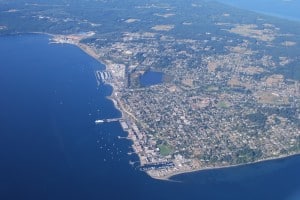
Along the way we passed by Port Townsend, sitting at the NE tip of the Olympic Peninsula. It's home to the annual Wooden Boat Festival which just opened the day we flew over.
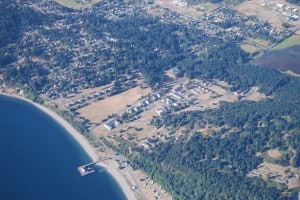
Fort Worden is located immediately to the right of the previous photo and on the north side of Port Townsend. It was an active U.S. Army base until 1953 and is now a state park. It was the movie setting for the 1983 film drama, An Officer and a Gentleman, starring Richard Geer as a U.S. Navy aviation officer candidate (the school for this is actually at NAS Pensacola in Florida, but they had to use Fort Worden as a stand-in). Kap and I toured the base about 30 years ago, when the old blimp hangar tucked in the trees to the right of center was in total disrepair - it has since been rebuilt and is now a performance theater that seats 880 people.
But we definitely needed to get away from it all. On Thursday, the 6th, we bundled up Gator and ZuZu, plus all the glimp required to travel with a dog and cat, and made our way to Kenmore Air at the north end of Lake Washington for a 9AM flight to April Point. It was a nice day to fly, but with lots of unstable air it was probably one of the roughest flights we’ve had going back and forth to the Inside Passage along Vancouver Island. That didn’t make ZuZu happy at all, and Gator looked green enough around the gills that I thought hard at one point about grabbing for the sick-sack in the seat pocket. He came through like a trooper, though, and slept curled up on his blanket on the floor of the aircraft for most of the way.
First stop after a 1+ hour flight north on Puget Sound was Nanaimo for the standard Canadian Customs clearance. That involves landing at the floatplane dock on the north side of town. Every Kenmore Air flight from Seattle heading to Canada departs around 9AM, and they swarm into this dock at about the same time – that way, the Customs people only have to come to the floatplane dock once. For the past several flights, we’ve been lucky to be on the first-arriving float plane, and that means we don’t have to wait long for Customs. Everyone has to deplane, but not your luggage, and standing by the side of the plane, your passports and cat/dog paperwork are looked over. After a half-dozen questions, they move on to the next person. It takes about 10 minutes to clear everyone on each plane, but then we stand around on one foot, then the other while they re-fuel the plane. We haven’t a clue why they don’t carry enough fuel for the entire flight, but it’s always this way, and we assume it has to do with fuel management.
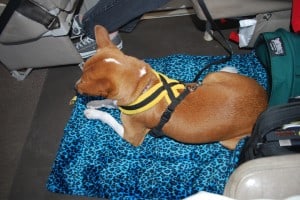
Gator asleep on his blanket on the floor of the Kenmore Air Otter floatplane on our way north to April Point. He can sleep just about anywhere. ZuZu, on the other hand, howled the entire time - but I'm sympathetic, as it has to be claustrophobic in the tiny Sherpa bag, completely dark inside, no way to see out, and the roar of the deHavilland Otter pretty much deafening her, particularly on the multiple take-offs.
By 10:30 we taxied away from the dock and made our second take-off of the morning. The next stop was an interesting one – in a tiny bay just south of Desolation Sound where a 40′ sailboat was anchored. We taxied to about 100′ from the sailboat to let off three young guys who were meeting up with their parents on the sailboat – and the exchange was directly to the sailboat’s dinghy from the plane’s floats. Kenmore Air has great service and quite often does a direct pickup or drop right at a boat?
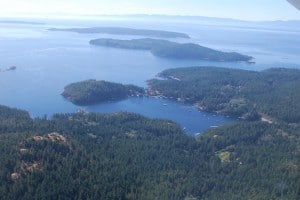
After our first drop-off at the sailboat at anchor in a secluded bay inside Desolation Sount, we headed west over Cortes Island. Out my window I snapped a photo of Cortes Bay. In the center of the photo, where you can see three empty finger-pier docks is the Seattle Yacht Club outstation - the jewel of the 11 outstations the Club owns between Gig Harbor (near Tacoma) and sprinkled along the San Juan and Gulf Island and up to Desolation Sound. The docks are completely empty of boats, which is exactly how we like it - and it's the main reason we prefer to cruise around here after Labor Day when all of the other cruisers have gone home. At the lower right of the bay (and not in sight in the photo) is the Royal Vancouver Yacht Club outstation. The island just above (to the south) of Cortes Bay is actually two islands, called aptly enough, Twin Islands, that are connected by a small neck. Just off the shore where they join is our favorite prawning spot in this area.
Our third stop was at the tiny village of Manson’s Landing on the south tip of Cortes Island – which is sort of the gateway to Desolation Sound. One passenger got off there, and we were back in the air in less than five minutes for our fourth take-off. This time it was a short tree-top flight over Cortes Island, heading towards Campbell River (actually, almost all flights on Kenmore Air are tree-top height, but this one was more so due to the short distance).
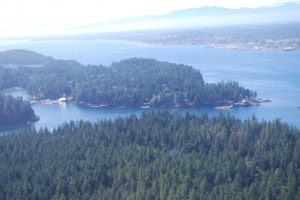
We're on our downwind leg for an approach to land at April Point Marina. The marina is tucked deep into a bay on Quadra Island, situated directly across Discovery Channel to the east from Campbell River. Near shore at the marina are two boat houses, and out on the dock you can barely make out a couple of boats - one of them is Flying Colours, hopefully safe and sound after a month waiting for us to return. The marina is part of the April Bay Resort, and the lodge for it is at the right on the tip of the bay opening to the right. Toward the top of the marina (from where Flying Colours is), there's a sliver of land that's another bay where a ferry across to Campbell River runs on the hour. The mountains that form the spine of Vancouver Island are in the background to the right.
Our own stop, the fourth of the morning, was at April Point Marina, tucked into a fairly well protected bay on the west side of Quadra Island, directly across Discovery Channel from Campbell River. As we taxied up to the floatplane section of the marina’s dock, we could see Flying Colours on the dock just inboard from us.
Before heading home a month earlier, we’d arranged with a young woman who details boats around the marina to wash and clean up the exterior of Flying Colours, and it was gleaming for our arrival.
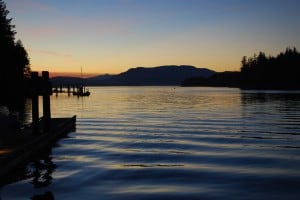
The sunsets at this latitude along the Inside Passage - and at this time of year - never disappoint us. This bronze-colored beauty is from our bow at the dock in April Point Marina, looking north along Discovery Channel towards Seymour Narrows.
It didn’t take long to get settled aboard Flying Colours once again. Our biggest need was for provisioning of fresh meats and vegetables, so after getting Gator and ZuZu safely aboard we arranged with the wharfinger to give us a lift to the local grocery store. It’s not a big store, but since it’s a ferry ride and a lot of walking to the really good supermarket in Campbell River, we figured we’d get what we could and leave the rest for the next day’s shopping in the supermarket.
The next morning (Friday, the 7th), we got another lift from the marina staff to the ferry terminal for the half-hour ride across Discovery Channel to Campbell River. After lunch in the big city (population 31,000), the supermarket is about a mile walk, so we’d brought along our wheeled carts to haul our groceries back to the ferry and across to Flying Colours. We were now stocked for almost two weeks, and hopefully we’d be out and about for this duration.
Early Saturday morning, Kap fired up the engines and we motored out of April Point and turned southward on Discovery Channel. At the south end of Quadra Island she turned east at Cape Mudge, with the plan to stop over at the Seattle Yacht Club outstation on Cortes Island to meet up with Steve and Shirley aboard the Couverden.
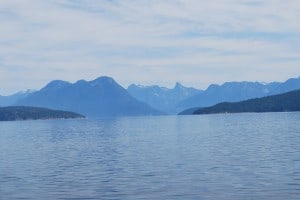
It was a great day for cruising. This photo was taken from the bow of Flying Colours off the south end of Cortes Island. The tilted pointy peak to the right of center is Mt. Denman, a 6,532' mountain at the eastern edge of Desolation Sound on the B.C. mainland. It rises directly from the sea and is the most distinctive mountain feature in Desolation Sound.
Halfway to Cortes, an e-mail from Steve popped up on my laptop. They had just departed from a two-night anchorage at a secret and secluded bay north of Desolation Sound – a place they call Oyster Island because they get a good haul of oysters on the beach. They’d been out of Internet and cell phone range since our arrival aboard Flying Colours, so it was by pre-arrangement that we were to meet up at Cortes Bay. They had just learned, though, that a multiple boat flotilla of SYC members who were hosting a contingent of New York Yacht Club members on a tour of our outstations were descending on Cortes Bay that day. In a back-and-forth e-mail exchange, we decided it wasn’t a good day after all to stop at Cortes Bay, and we decided to meet up in Prideaux Haven in the heart of Desolation Sound.
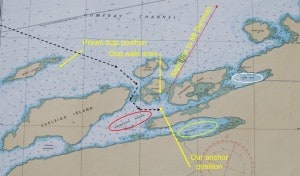
Prideaux Haven is the most popular spot in Desolation Sound, with as many as 75 boats during July and August anchored in this area that's probably a mile long, by half a mile wide. Another 30-40 boats are anchored (most of them stern-tied) in Melanie Cove and Laura Cove. When we arrived there were only four other boats in Prideaux Haven, but by nightfall there were 24 boats.
We arrived at the entrance to Prideaux Haven just before noon. With a dog leg type of S-curve that you have to execute, the entrance is almost completely hidden from the outside and you’d likely cruise right past it if you didn’t know it was there (or if you didn’t have a paper or electronic chart to show the way). The entrance is a little narrow, but only in one spot, and there are rocks that almost reach the surface at low tide that you have to weave your way through. The first couple of times we visited here we always had one of us on the bow to watch for rocks ahead, but now we feel comfortable enough to just follow the electronic chart plotter screen image. We had about 18′ of water below the keel as we motored through this time.
Once inside, we found there were few enough boats that we could pick our favorite spot and we dropped anchor. We’ve never been here during a storm, nor have we ever had a problem with the anchor biting and holding on the bottom, so we were rather casual about making sure it was set. Our anchor depth was 42′, so knowing there was a bit of wind coming up in the forecast, we laid out 150′ of chain to give us 3-1 scope. We figured that would be enough to firmly hold us in a moderate blow.
We then got the dinghy down, the prawn traps set up, and after taking Gator ashore to do his business, we headed out to the channel along Mary Island and dropped our baited traps in just over 300′ of water.
As we were lowering the traps, and to our chagrin, a seemingly endless parade of boats arrived and made their way through the entrance to Prideaux Haven. We found on our return that two of them, both sailboats of about 34-36′, had anchored directly in front of us, and one of them (we felt) had almost surely dropped his anchor (or laid out his chain) on top of ours. This was troublesome, as we knew a “blow” was due in the next couple of days and the last thing we wanted was a snarled anchor if we started to drag our anchor, or worse, pull out our anchor if one of them started to drag his anchor. We didn’t say anything, but in hindsight, we should have. It’s an almost certain confrontational situation, and not one that anyone looks forward to.
Steve and Shirley, who were anchored about 100′ behind us, dropped by late in the afternoon for Happy Hour and a chance to catch up on each other’s news since we’d last seen them in Port McNeill a month earlier. They’ve now been on Couverden since early June, and in between weeks when Shirley flies home to Port Angeles to check in on her ailing mother, they’ve been lazing around, doing a lot of fishing, crabbing, and prawning. Their freezer was jam packed with seafood they’ve caught or trapped this summer, so they didn’t even bother with their prawn traps here at Prideaux Haven.
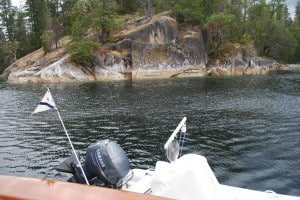
When we first dropped our anchor we were this far from the rock face rising vertically out of the water to the north of us - probably over 200' away. We had 150' of chain out, so I figured we were quite safe if the wind blew us towards this side of the bay. At the time we set our anchor, Kap was concerned that we were too close to the rock shore, but I told her, "Nah, we're in good shape?" - after all, Kap's never seen an anchorage that she liked, and I tend to drop and set the anchor and not worry too much about it.
We decided to leave our prawn traps out for an overnight soak. This usually isn’t the best idea as it gives the little critters time to squeeze through the netting and escape, as well as more time for an octopus, crabs, star fish, or other shag nasties to get into the traps to eat the prawns. First thing in the morning, Kap and I dinghied out to pull our prawn traps, hoping for a good catch of at least 100-125 across our two traps – and were disappointed with a measly 24, and all of them fairly small. It was pretty certain that the summer crowds ahead of us had cleaned out the area, but we decided to drop our traps for another try at a nearby spot.
With the forecast winds and some rain scheduled for around 4PM, we begged off on a Happy Hour invitation for wine and pupus on the Couverden. As the wind began to pick up,we could easily see that our anchor chain (but likely not our anchor) was being pulled out tight, and was probably starting to pull pretty hard on the anchor. We hoped aloud that our anchor was indeed set deep into the bottom muck and that we’d hold during the night. We were already closer to the rock wall than when we dropped anchor, and at times we were closer to the sailboat nearest us than when he dropped his anchor. An uneasiness began to grow in both of us. As always, Kap had set a GPS marker on our chart plotter where we’d dropped our anchor, and better, she’d turned on the “tracking” feature – that shows with a continuous line on the screen exactly where the boat has moved.

The Andante, another Fleming from Seattle made a drive-by of Flying Colours and Couverden as she entered Prideaux Haven, looking for the best anchorage spot to ride out the night's storm.
Just as we were preparing to take Gator ashore for the last time, we spied a Fleming winding through the rocks at the entrance to Prideaux Haven. With a short cockpit we could tell it was an older Fleming 55 – from the very early days when Tony Fleming felt the boat was better if he “dammed” the mold 2-5′ from the stern and actually built a 50′ or 53′ boat from the 55′ mold. This was obviously a 50′ or 53′ Fleming coming towards us, and it wasn’t until she was close enough to us to read her boat name board next to the pilot house door that I saw it was Andante, a friend from Seattle.
As the Fleming paraded by us, Robin Gainey, the owner of Andante stepped out of the pilot house and waved to us. Robin is cool. Married to a Boeing 787 design engineer who’s been working night and day for several years now on getting the new 787 into the air, and with at least three kids, Robin takes off each summer from Seattle in June or July, by herself, and brings Andante up to the Desolation Sound area where she spends the entire summer on her freelance writing, mostly magazine articles that she sells. She just completed her first book – an e-book that’s for sale on amazon.com – called Jack of Hearts, a good little story about a Jack Russell living in Italy that I highly recommend (if you’re interested, you can read about it – and Robin – at www.robinfgainey.com).
Robin had been anchored north of Desolation Sound in a secluded bay, trying to get some writing done, but with a weather forecast there for 40 knot winds, she decided to high tail it down to Desolation Sound where she hoped to find a bit more protected anchorage.
During our shore leave with Gator, the sky clouded over with ominous-looking thunderstorm clouds, the temperature dropped, the winds began to rise, and a few drops of rain hit us. Just as darkness fell, the storm picked up in a fury, with lashing rain and sustained wind gusts of almost 30 knots. As we ate dinner, we could tell that the winds were pulling us closer to the rock wall behind us. With the low clouds and heavy rain, it was total darkness outside and all we could see were the anchor lights at the top of sailboat masts or on the highest spot on the powerboats – except for the damn sailboat nearest to us, who had failed to turn on his anchor light (which is required by Coast Guard regulation for any boat at anchor overnight).
While I closely watched the radar screen, Kap kept an eye on the chart plotter tracks of our movement, and both of us glanced constantly at the wind gauge. Every time a strong gust hit us we could see the movement closer to the rock wall, and to the sailboat near us. We frequently raced to the cockpit and with a strong night scuba diving flashlight that we always have aboard, we shined it over to the sailboat to see for ourselves just how close he was to us. There weren’t any lights showing from the interior of the sailboat, and knowing the guy on board was an old-timer, he was probably in bed, not worried at all that he might drag his anchor and smash into the rocky shoreline, or worse, into us. At one point I yelled, “Turn on your damned anchor light!” at the top of my voice, but the wind and rain just drowned it out.
On our starboard side was the Couverden, and while we were slowing moving towards her as well, we weren’t as concerned about her as the sailboats and the rock wall on the shore. We talked back and forth several times on our cell phones with Steve and Shirley, comparing notes on what each of us thought was the most accurate part of the various weather forecasts we’d heard through the afternoon and evening. Soon, there were no salon lights in the Couverden, and we figured they probably went to bed, feeling a bit more secure about their situation than we did.
It was obvious this was going to be a long night. The forecast was for the winds to die down by morning, and the rain was scheduled to stop before midnight. We sat glued to the instrument console through 10 o’clock, then 11 o’clock, then midnight. The rain stopped, and slowly but surely, the winds lessened to the teens, with just the occasional gust to the mid-20s. We began to have a bit more visibility, and it just seemed to feel a bit more secure outside. Finally at 1PM when both of us were exhausted, we agreed that the best way to get through the night was to take half hour shifts on anchor watch while the other snatched a few minutes of sleep. Kap opted for the pilot house settee, and I made up a temporary bed on the salon settee.
At one point in the night, I awoke with a start to the sound of our bow and stern thrusters being run. I rushed to the pilot house and Kap exclaimed that we were within 20′ of the rock face on the shore and she decided it was time to move us away from it. After that, things improved hour by hour, and at 6AM with the first morning glimmers of light it looked like we’d made it successfully through the night. Both of us were dog tired, but safe.
After taking Gator ashore for his morning constitutional, we headed out in the dinghy to pull up our prawn traps. We didn’t have high expectations, but we also didn’t expect to get skunked. We pulled up a piddly 12 prawns, plus two more that were females filled with eggs – and for obvious reasons they have to be thrown back. It was definitely the end of the prawning season for us, and we decided not to reset our traps and bring them back with us. To make matters worse, when we stopped off at Adante to see how Robin fared during the night, our dinghy motor wouldn’t start when we tried to go. We had plenty of fuel, the battery was fully charged – the starter just wouldn’t engage. Giving up, we had to be towed back to Flying Colours.
Back on our boat, and in all honesty, we felt like heading for bed – a real bed – for a good night’s sleep. Instead, we talked over our options for what to do next. Without a dinghy, it wasn’t possible to be at anchor any longer, and it isn’t safe to be doing any serious cruising either. Steve and Shirley were planning to head over to Cortes Island and the outstation, and after changing our minds this way and that several times, we decided it was the best thing for us too. We raised the dinghy to the upper deck and made ready to depart.
The trip over to Cortes Island was a quick 1 1/2 hours, and to our surprise the place was totally deserted when we arrived. From the member sign-in sheet at the clubhouse, we knew there had been a contingent of members who had passed through while we were at Prideaux Haven, but now they were all gone.
Oddly enough, the dinghy engine now starts just fine, and this afternoon we’re getting things ready to start heading south tomorrow. Our current plan is to cruise down the Strait of Georgia along the east side and into the SYC Garden Bay outstation in Pender Harbour for a few days.
I’m sure we’ll have one or two more adventures before the end of this summer.
So long from Flying Colours.
Ron

